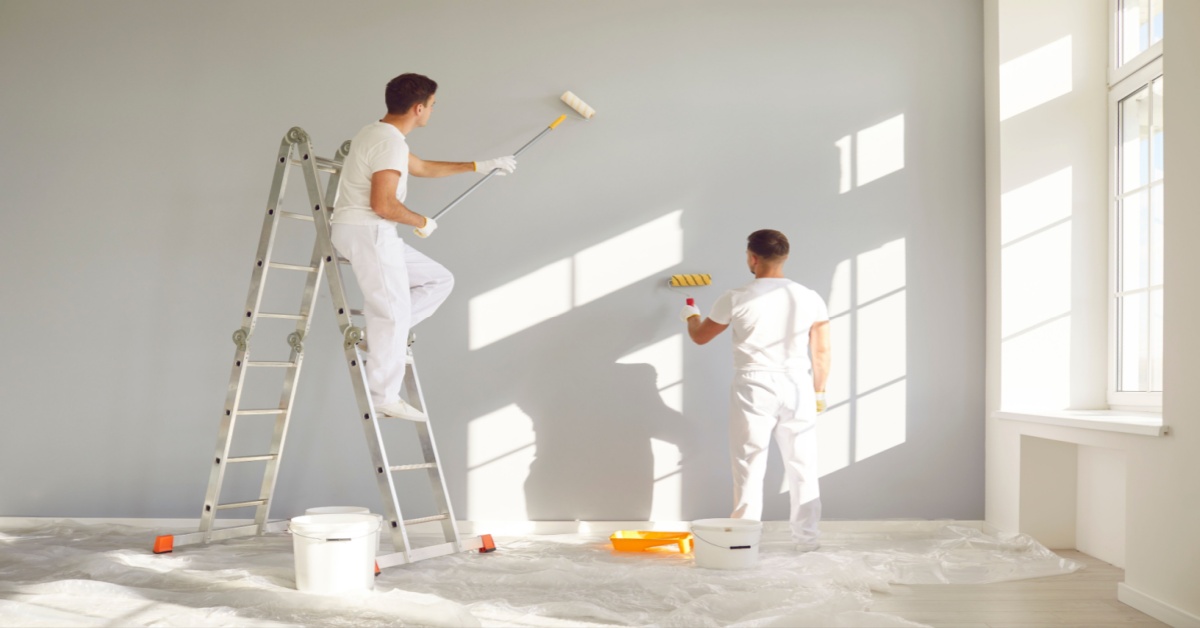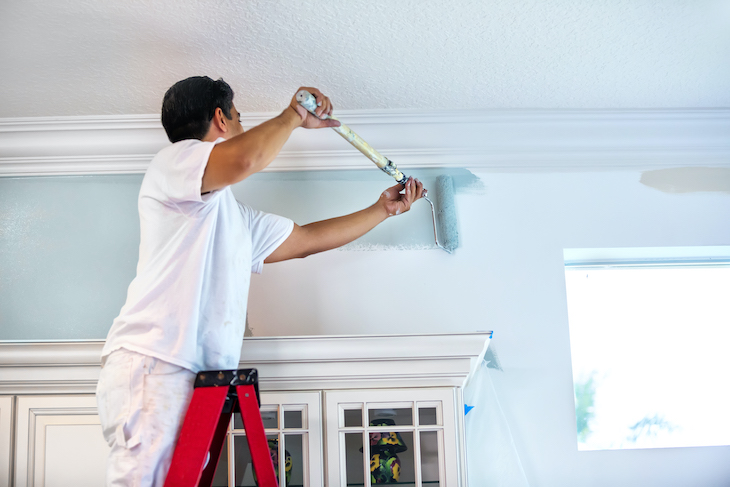Exploring the Different Kinds of Paint: A Guide for every single Job
Checking out the various kinds of paint is essential for achieving the desired outcome in any type of job. From water-based options that offer ease to oil-based paints understood for their toughness, each option has its benefits. Specialized paints can include distinct appearances or surfaces, while green choices satisfy those looking for sustainability. Comprehending these differences can considerably affect the success of a paint endeavor. What elements should one consider when making the appropriate option?
Recognizing Paint Kinds: Water-Based vs. Oil-Based
Paint kinds can significantly impact a task's end result, and comprehending the differences in between water-based and oil-based paints is vital for informed decision-making. Water-based paints, typically referred to as latex paints, are made up of water as the primary solvent. They completely dry quickly, discharge fewer unpredictable organic substances (VOCs), and are easy to tidy up with soap and water. This makes them a popular option for indoor applications and environments where air quality is a worry.
In contrast, oil-based paints make use of natural solvents, offering a sturdy, glossy finish suitable for surfaces exposed to damage, such as trim and cabinets. They take longer to dry, call for mineral spirits for cleanup, and have a stronger smell. benjamin moore paint store corpus christi. Choosing between these two kinds relies on the specific requirements of the task, considering elements such as preferred coating, application setting, and ease of maintenance. Each type has distinctive benefits and restrictions, assisting the option process
The Finish Matters: Selecting In Between Matte, Satin, and Gloss
When selecting a paint finish, the option between matte and shiny choices substantially impacts both looks and capability. Matte finishes offer a subtle, non-reflective look that can hide surface imperfections, while glossy finishes offer toughness and convenience of cleansing. Understanding the benefits and considerations of each can help in making a notified decision for any type of painting job.
Matte Complete Benefits
Although numerous house owners dispute the qualities of numerous surfaces, matte paint offers distinctive advantages that make it a prominent option for both exterior and interior applications. Among the main advantages of matte coating is its capacity to hide surface area blemishes, producing a smoother appearance on wall surfaces. This high quality is particularly advantageous in older homes or areas with uneven surfaces. Furthermore, matte paint absorbs light as opposed to mirroring it, which can improve the aesthetic of a room by giving a more low-key and innovative appearance. Moreover, matte coatings are often less complicated to touch up than glossier alternatives, as they can blend much more effortlessly when applied over existing paint. Overall, matte paint is an excellent selection for those looking for a refined and stylish surface.
Glossy Complete Considerations
A shiny coating can considerably alter the understanding of an area, using a streamlined and reflective quality that enhances both shade vibrancy and light within an area. This coating is frequently favored for high-traffic areas and surfaces like kitchen areas and restrooms, where resilience and simplicity of cleansing are crucial. Nonetheless, its reflective nature can highlight imperfections on walls, making appropriate surface area preparation critical. Shiny paints also tend to show finger prints and spots quicker, necessitating normal maintenance. Furthermore, illumination plays a significant duty; in intense environments, a glossy coating might develop glow, affecting the general aesthetic. Consequently, cautious consideration of the certain application and setting is crucial when selecting a shiny surface for any type of job.
Specialized Paints: When to Make Use Of Distinctive or Chalk Paint
Specialized paints, such as textured and chalk paint, offer unique aesthetic and useful benefits that can boost different surfaces. Textured paint is perfect for developing depth and measurement on wall surfaces, hiding imperfections while including a three-dimensional feeling. It is particularly useful in high-traffic locations where longevity and aesthetic passion are vital.

Both kinds of specialty paints can transform areas, yet selecting the right one depends upon the preferred result and surface area demands. Textured paint might fit larger areas, while chalk paint can revitalize smaller sized things, showcasing creativity and personal design in any type of project.
Exterior Paints: Protecting Your Surfaces From the Elements
Exterior paints are vital for protecting surface areas versus numerous weather. Understanding their weather resistance functions, proper surface area prep work needs, and reliable application techniques can substantially enhance sturdiness and efficiency. This area will detail vital factors to consider for choose and utilizing exterior paints effectively.
Weather Condition Resistance Features
Weather resistance is a crucial function of outside paints, as it determines exactly how well surface areas can withstand the extreme aspects of nature. High-grade outside paints are developed helpful hints to withstand damage from UV rays, dampness, and temperature variations. UV resistance assurances colors continue to be dynamic gradually, avoiding fading and staining. Dampness resistance protects versus mold and mildew and mold, which can compromise the honesty of surfaces. Furthermore, paints with exceptional temperature resistance can contract and expand without fracturing, maintaining their protective qualities. When selecting exterior paints, it is important to take right into account these weather condition resistance functions, as they add to the longevity and resilience of coloured surface areas, making specific they continue to be cosmetically pleasing and functional regardless of exposure to the aspects.
Surface Prep Work Demands
Appropriate surface preparation is a fundamental action in achieving the very best outcomes with outside paints. To guarantee ideal adhesion and resilience, surfaces need to be extensively cleaned up, eliminating dust, oil, and mildew. This can be completed making use of a stress washing machine or a scrub brush with a suitable cleaning remedy. Once cleaned up, surfaces must be inspected for any type of peeling or flaking paint, which have to be scratched away to develop a smooth structure. Fixing any type of splits or holes is additionally crucial, as these can enable moisture infiltration. Additionally, fining that site sand harsh locations advertises better paint attachment. Applying a primer suited for exterior usage can boost the paint's performance, guaranteeing a durable surface that endures the elements. Correct prep work is essential to an effective exterior painting job.
Application Methods Tips
While using exterior paints, it is important to utilize effective strategies that guarantee surface areas are well-protected versus the components. Select the best day for paint; low moisture and mild temperature levels enhance bond and drying. Prepping the surface thoroughly-- cleaning, fining sand, and priming-- guarantees far better paint adhesion and toughness. Using top notch brushes or rollers can provide a smoother coating, while spray painting may cover huge areas effectively. Using paint in thin, even layers prevents drips and runs. It is suggested to comply with supplier instructions pertaining to drying times between layers. Ultimately, confirm correct air flow during application to help with visit homepage drying out and decrease exposure to fumes. These techniques greatly enhance the durability and efficiency of outside paint.
Eco-Friendly Options: Low-VOC and Zero-VOC Paints
As customers come to be increasingly aware of the environmental effect of their options, zero-voc and low-voc paints have actually arised as popular alternatives. These paints are formulated to include fewer unstable organic compounds (VOCs), which are chemicals that can evaporate into the air and add to air pollution and health issue. Low-VOC paints normally have a minimal quantity of VOCs, while zero-VOC paints have negligible levels, making them safer for both indoor and outdoor usage.
The advantages of making use of zero-voc and low-voc paints prolong beyond environmental considerations; they also improve interior air top quality, minimizing the danger of breathing concerns and sensitive responses. Many manufacturers currently supply a selection of shades and surfaces in environment-friendly choices, making it simpler for consumers to locate appropriate items for their jobs. By opting for these paints, people can add to a healthier environment while still attaining the aesthetic they desire in their rooms.
Devices and Methods for a Flawless Application
Achieving a perfect paint application requires the right devices and methods, which can greatly boost the result. Selecting the ideal brush or roller is crucial; brushes work well for sides and intricate locations, while rollers cover bigger surface areas efficiently. Making use of top notch materials assures better paint circulation and reduces touches. For perfect outcomes, surface area preparation is critical. This includes cleansing, sanding, and priming surfaces to advertise adhesion.
Method also plays a significant function. The "W" method with a roller assists to equally distribute paint, while long, smooth strokes with a brush stop noticeable lines. Working in areas permits for much better control and blending. Furthermore, using slim coats is more effective to thick layers, lowering the risk of drips and unequal appearances. Lastly, keeping a wet edge throughout application aids achieve seamless modifications in between locations. By combining these techniques and tools, one can accomplish a refined and specialist finish.
Tips for Maintaining and Caring for Your Painted Surfaces
Appropriate upkeep and treatment of coloured surface areas can greatly extend their lifespan and preserve their appearance. Routine cleansing is essential; using a soft cloth or sponge with moderate soap and water can eliminate dirt and dirt without damaging the paint. It is advisable to stay clear of unpleasant cleaners or rubbing pads, as these can scratch the surface. Furthermore, applying a fresh coat of paint every few years can invigorate the color and secure versus wear.
For exterior surface areas, checking for indications of peeling or fading on a regular basis is very important. Without delay attending to any type of problems avoids more damages. In areas prone to dampness, such as washrooms, making use of mold-resistant paint and making sure proper ventilation can aid preserve the integrity of the paint. Ultimately, using protective coatings can protect against UV rays and discolorations, making certain that repainted surface areas continue to be enticing and lively for years ahead, eventually improving the total visual of the area.
Regularly Asked Inquiries
Can I Mix Different Types of Paint Together?
Mixing various kinds of paint is generally not recommended, as it can lead to issues like poor attachment, inconsistent texture, or unexpected chain reaction. It's best to make use of suitable paints for excellent outcomes and longevity.

Exactly how Do I Effectively Shop Leftover Paint?
To appropriately save leftover paint, seal the container securely, tag it with the date and color, and keep it in a trendy, dry location far from straight sunlight and extreme temperatures for excellent preservation.
What Is the Best Method to Dispose of Unused Paint?
The very best means to deal with unused paint is to inspect regional laws, as many areas have designated contaminated materials centers. Think about giving away useful paint to community companies or institutions for their projects.
How Can I Tell if Paint Is Still Great to Use?
To figure out if paint is still excellent, analyze its shade, consistency, and smell. If it appears apart, has an unpleasant odor, or reveals considerable modifications in texture, it's most likely no more functional.
Are There Age Restrictions for Buying Paint Products?
In numerous regions, there are no certain age limitations for purchasing paint items. Nonetheless, some stores might call for clients to be a minimum of 18 years of ages, especially for products containing solvents or unsafe materials.
Paint kinds can substantially affect a project's end result, and comprehending the differences in between water-based and oil-based paints is essential for educated decision-making. Water-based paints, typically referred to as latex paints, are made up of water as the main solvent. In contrast, oil-based paints make use of organic solvents, giving a durable, shiny finish ideal for surface areas revealed to tear and wear, such as trim and cupboards. Specialized paints, such as textured and chalk paint, deal unique visual and practical benefits that can boost various surface areas. In locations prone to wetness, such as bathrooms, utilizing mold-resistant paint and making certain proper air flow can aid maintain the stability of the paint.